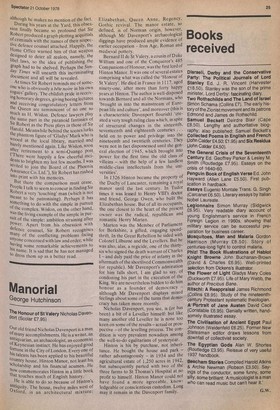Manorial
George Hutchinson
The Honour of St Valery Nicholas DevenPort (Scolar £7.95) Our old friend Nicholas Davenport is a man of many accomplishments. He is a writer, an antiquarian, an archaeologist, an economist of Keynesian instinct. He has enjoyed good hfortune in the City of London. Every one of is talents has been applied to his beautiful country house, Hinton Manor, not least his scholarship and his financial acumen. He now commemorates Hinton in a little book that touches much of English history. He is able to do so because of Hinton's antiquity. The house, twelve miles west of Oxford, is an architectural mixture: Elizabethan, Queen Anne, Regency, Gothic revival. The manor estate, so defined, is of Norman origin, however, although Mr Davenport's archaeological diggings have produced ample evidence of earlier occupation — Iron Age, Roman and medieval pottery. Bernard!! de St Valery, a cousin of Duke William and one of the Conqueror's 485 Companions of Honour, was the first lord of Hinton Manor. It was one of several estates comprising what was called the 'Honour of St Valery'. He died in France in 1117, aged ninety-one, after more than forty happy years at Hinton. The author is well-disposed towards Bernard and all the Normans, who 'brought us into the mainstream of European life and culture', and moreover (this is a characteristic Davenport flourish) 'created a very tough ruling class which, in spite of structural changes in the sixteenth, seventeenth and eighteenth centuries ... held on to power and privilege into the nineteenth and twentieth centuries. They were not in fact dispossessed until the general election of 1945, which brought into power for the first time the old class of villeins — with the help of a few landless middle-class intellectuals from the universities'.
In 1326 Hinton became the property of the Duchy of Lancaster, remaining a royal manor until the last century. In Tudor times it was leased to Henry VIM doctor and friend, George Owen, who built the Elizabethan house. But of all its occupants, the one closest to the heart of the present owner was the radical, republican and romantic Henry Marten. Marten was the Member of Parliament for Berkshire, a gifted, engaging spendthrift. In the Great Rebellion he sided with Colonel Lilburne and the Levellers. But he was also, alas, a regicide, one of the thirtysix who signed the death warrant of Charles I — and duly paid the price of infamy in the aftermath of the shortlived Commonwealth (or republic). Mr Davenport's admiration for him falls short, I am glad to say, of condoning his part in the execution of the King. We are nevertheless bidden to do him honour as a founder of democracy — although Mr Davenport displays mixed feelings about some of the turns that democracy has taken more recently. Nicholas Davenport, you see, is (or has been) a bit of a Leveller himself: but like many another old Leveller he is none too keen on some of the results— actual or prospective — of the levelling process. The condition is very prevalent nowadays among the well-to-do egalitarians of yesteryear..
Hinton is his by purchase, not inheritance. He bought the house and park — rather advantageously — in 1934 and the agricultural estate of 1,250 acres in 1942, but subsequently parted with two of the three farms to St Thomas's Hospital at no profit to himself. Hinton Manor could not have found a more agreeable, knowledgeable or conscientious custodian. Long may it remain in the Davenport family.






































 Previous page
Previous page